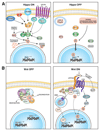YAP/TAZ upstream signals and downstream responses
- PMID: 30050119
- PMCID: PMC6186418
- DOI: 10.1038/s41556-018-0142-z
YAP/TAZ upstream signals and downstream responses
Abstract
Cell behaviour is strongly influenced by physical, mechanical contacts between cells and their extracellular matrix. We review how the transcriptional regulators YAP and TAZ integrate mechanical cues with the response to soluble signals and metabolic pathways to control multiple aspects of cell behaviour, including proliferation, cell plasticity and stemness essential for tissue regeneration. Corruption of cell-environment interplay leads to aberrant YAP and TAZ activation that is instrumental for multiple diseases, including cancer.
Conflict of interest statement
The authors declare no competing interests.
Figures



References
-
- Vogel V, Sheetz M. Local force and geometry sensing regulate cell functions. Nat Rev Mol Cell Biol. 2006;7:265–275. - PubMed
Publication types
MeSH terms
Substances
Grants and funding
LinkOut - more resources
Full Text Sources
Other Literature Sources
Medical

